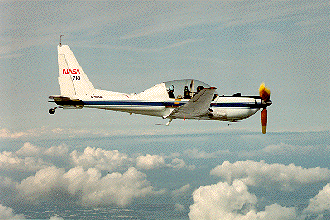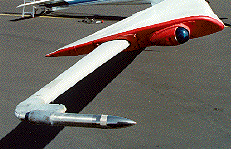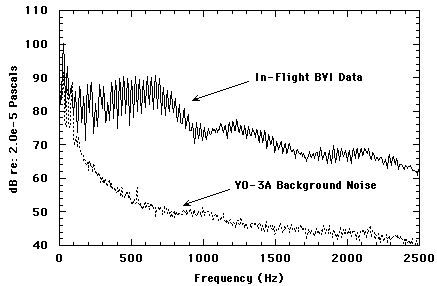In-Flight Rotorcraft Acoustics Program

The YO-3A Acoustics Research Aircraft. The tail microphone is at the top of the YO-3A's tail fin.
The YO-3A
The YO-3A Acoustics Research Aircraft. The tail microphone is at the top of the YO-3A's tail fin.
Originally built as a miniature, ultra-quiet spy plane, the Lockheed YO-3A was converted into a noise research platform. NASA, in cooperation with the Army, added microphones on the wing tips and tail fin, along with a data-recording system. An air-data boom was installed under the left wing. The sailplane wing, muffled engine, and slow-turning, belt-driven propeller keep the noise extremely low -- enough so as to allow accurate measurement of rotor noise from a nearby helicopter or tiltrotor.
The YO-3A has a condenser microphone mounted at each wing tip and one mounted at the top of the vertical tail. The microphones have a 0.5-inch diameter and are fitted with bullet-shaped nose cones. Each bullet fairing has a porous screen that allows the acoustic signal to reach the microphone diaphragm. The fairings are pointed forwards to minimize local flow separation and consequent background noise.

A close-up of the starboard wingtip microphone. The light-colored band just behind the bullet nose is a perforated screen that surrounds the microphone diaphragm.

YO-3A background noise compared to typical BVI data. (Signor, et al., 1994)
For IRAP tests, the YO-3A flies below and ahead of the aircraft being tested, where BVI noise is typically loudest. BVI occurs primarily during descending forward flight, so the YO-3A establishes a steady descent and the helicopter or tiltrotor follows it down. To help set up and maintain formation, the helicopter copilot uses a hand-held laser rangefinder to continuously measure distance from the YO-3A.
For helicopters that do not have full suites of flight test instrumentation, NASA developed a portable, on-board data system to complement the YO-3A's acoustic-data system. The portable system measures and records fuselage attitude together with the distance measurements from the laser rangefinder. The data recorders in the YO-3A and the test helicopter both record a synchronization signal (1/rev pulse) once each rotor revolution; a transmitter broadcasts the synchronization signal and an IRIG-B time code from the test aircraft to the YO-3A.
IRAP tests have been carried out with Sikorsky S-76C, MBB BO 105, and Sikorsky UH-60A helicopters, and most recently the Bell XV-15 tiltrotor. In addition to IRAP tests, the YO-3A was used for earlier acoustics tests with a Bell UH-1H "Huey," two models -- AH-1S and AH-1G -- of Bell Cobras, McDonnell Douglas AH-64 Apache and MD 500 helicopters, and the YUH-61 and YAH-63 prototype military helicopters. (See the history section.) The YO-3A was also used to measure sonic booms from an SR-71 "Blackbird."
Related Publications:
"YO-3A Acoustic Research Aircraft Fact Sheet." NASA Information Bulletin, December 1983.
Cross, J. L. and Watts, M. E. "In-Flight Acoustic Testing Techniques Using the YO-3A Acoustic Research Aircraft." NASA TM-85895, February 1984.
Lamberton, B. "Quiet Star -- We Fly Lockheed's Bargain Basement Spy Plane." Air Progress Vol. 43. No. 6, June 1981.
MacKnight, N. "NASA's Quiet Side, Part Three: The YO-3A." Air International, July 1992.
McCluer, M. and Dearing, M. "Measuring Blade-Vortex Interaction Noise Using the YO-3A Acoustics Research Aircraft." 22nd European Rotorcraft Forum, Brighton, UK, September 1996.
Signor, D. B., Watts, M. E., Hernandez, F. J., and Felker, F. F., "Blade-Vortex Interaction Noise: A Comparison of In-Flight, Full-Scale, and Small-Scale Measurements." American Helicopter Society Aeromechanics Specialists Conference, San Francisco, CA, January 1994.
See also the references page.
Point of Contact:
C. W. Acree
NASA Ames Research Center
Moffett Field CA 94035-1000